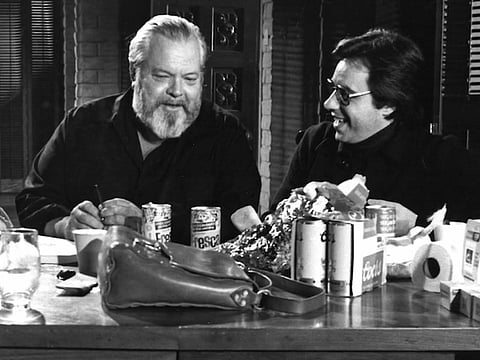Peter Bogdanovich on finishing Orson Welles’ film
‘The Other Side of the Wind’ is the legendary filmmaker’s final movie

It was to be the great director Orson Welles’s big comeback, marking his triumphant return to the United States after a quarter century in the wilderness in Europe.
But The Other Side of the Wind, a satire on the death of Hollywood’s golden age and the legendary filmmaker’s final movie, remains unfinished after decades of financial problems and legal battles.
Internet streaming service Netflix announced in March it would fund the completion and restoration of the movie — enabling its star Peter Bogdanovich to fulfil a promise he made to Welles before his death in 1985, he revealed on Friday.
“Somewhere in the period 1974 or 1973, Orson and I were having lunch and he turned to me and said, ‘If anything ever happens to me I want you to promise me you’ll finish the picture,’” Bogdanovich, 77, told a Q&A in Hollywood as part of the TCM Classic Film Festival.
“I said ‘Oh Orson, don’t say that’ and he said, ‘I know, nothing’s going to happen to me but, if it does, I want you to promise me the finished picture. I said, ‘Of course I will.’”
Shot by Welles between 1970 and 1976 from a screenplay he co-wrote with his lover Oja Kodar, The Other Side of the Wind stars the actress alongside Bogdanovich, John Huston and Dennis Hopper.
Veteran producer Frank Marshall, who was Steven Spielberg’s right-hand man on many of his biggest movies, worked on the original production and he and Bogdanovich have been at the forefront of efforts to complete it since Welles died of a heart attack.
Setbacks
He will lead the project for Netflix in consultation with Bogdanovich, who has numerous acting credits but is best known as the director of drama The Last Picture Show and screwball comedy What’s Up, Doc? in the early 1970s and Mask in 1985.
Welles was acclaimed for numerous movies which have since become classics, including Citizen Kane and Touch of Evil, but he never made a movie that turned a profit in his lifetime and is sometimes referred to as The Glorious Failure.
His art often mirrored his life, and his final film accordingly tells of the last days of a legendary director named Jake Hannaford (Huston) as he struggles to forge his last great comeback as a major filmmaker.
Initially funded by Welles, The Other Side of the Wind was filmed over six years around Los Angeles and in Arizona, Connecticut, England, France, the Netherlands, Spain and Belgium.
Principal photography began in 1970 but was delayed for two years when the US government decided that Welles’s European organisation was a holding company rather a production company and handed him a huge tax bill.
Production was further set back by an investor fleeing after allegedly embezzling a large part of the budget, as well as the collapse of promised investment and squabbles with Iranian backers.
The final scene was committed to celluloid in January 1976 but by then the money had run out, leaving Welles to spend the years up to his death editing in his spare time.
Funny
Decades-long legal battles have ensued between Welles’s daughter and his lover — and even the government of Iran — over the ownership of the film, with the negative locked in a vault in Paris.
Bogdanovich first announced in 2004 that he planned to restore the film and, three years later, said all the parties with competing claims over the movie had come to an agreement, with a theatrical release planned for late 2008.
Further wrangles stalled production, however, and the movie has been on hold ever since.
But Bogdanovich said the original negative and other footage had arrived in Los Angeles in March, officially resuming the post-production process.
“Ever since he died I’ve been trying to finish this picture... and now Netflix are doing it and we’re going to begin cutting at the end of this month,” he told the festival panel in Hollywood.
Ten hours of raw footage exist, but Welles never recorded the opening narration and one of the locations where a car crash has yet to be filmed no longer exists. Neither is there any kind of musical score.
But Bogdanovich is confident the final movie will be worth the wait.
“Huston is brilliant in it. I’ve seen a lot of his stuff, he’s just brilliant. It’s an amazing cast actually. Huston was funny because if an actor forgets a line, he usually says, ‘I’m sorry, what’s the line?’ or ‘line please!’” the filmmaker said.
“Not John. If he didn’t know the line he would say something, nothing to do with what the scene was about, but he’d say something and exit, leaving me on camera going ‘What?’ Orson always thought that was very funny.”
Sign up for the Daily Briefing
Get the latest news and updates straight to your inbox



